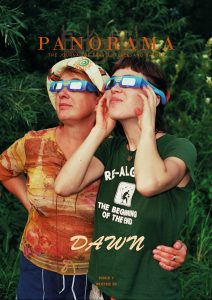Almost accidentally, we pulled into the car park at Stoneyfield Farm, to a path on the headland of Stornoway Harbour. It was a path I’d never trod before, despite being born and bred on this island.
Along the coast is often cold and blustery, as it was that afternoon. Dark waves lapped against the hill. The spring wind was sharp as it lapped against us. The hill gathered before us, grass yellowed brown with winter.
We passed the fenced-off electricity station owned by Scottish and Southern. The path wound round it, scattered with stones, and we followed, trying our best to avoid the numberless pellets of sheep and rabbits. The path led us round the hill to a promontory overlooking the Minch, the stretch of sea between the Isle of Lewis and the Scottish mainland. We paused on a spur of grass that, unlike the stark cliff-drop coastline of much of the island, rolled down to a brief rocky shore and into the sea.
A stark stone obelisk stands at the peak, plain and gray. It is inscribed in both English and in Gaelic, the language of my Island.
In grateful memory of the brave men of the Royal Navy who lost their lives in the Iolaire disaster at the Beast of Holm on the first of January 1919. Of the 205 persons who were lost, 175 were natives of the Island, and for them and their comrades Lewis still mourns, with gratitude for their service and in sorrow for their loss.
The Wreck of the Iolaire; the greatest maritime disaster in peace-time since the sinking of the Titanic. After surviving the battlefields of the first World War, 205 passengers and crew perished almost within sight of their homes.
A pile of white stones stands alongside it, a cairn gathered up in 1919 to mark the tragedy, the wreck of the Iolaire. There are many such cairns spotted around the Highlands and Islands that commemorate an event or the passing of a beloved individual. Stones stand upright and unshakeable to represent insurmountable grief. Profound trauma becomes a physical feature of the landscape.
Lairg, the village where we lived on the mainland, stands at the foot of Ord Hill, beneath a cairn erected 5,000 years ago to mark the mourning of a Pictish tribe. The tradition continues to the present. People pile up rocks in memoriam of lost loved ones or historic events. Some pile next to lakes where a beloved drowned, or in the moor where someone was lost and never found.
The simple stone pile erected at the peak of this path in 1919 was made when the entire island would have known what it was for, but for my wife and I in the present day, it revealed little of the magnitude of the tragedy. With no details to explain, it marked only the presence of momentous grief.
Unmarked memorials only tell their story for a generation or two. It has come to light, as the Island commemorates 100 years since the tragedy, that many of those who lost their loved ones were as silent as the stones in the aftermath. It is still possible to meet someone who lost a beloved, or someone who remembers another’s loss. I heard a story about the aunt of an older lady from our neighborhood. When she heard that her lover was lost in the wreck, she didn’t speak for years.
Devastation takes time to heal. Suffering usually occurs, at least for a time, in silence.
At the moment the sea was calm despite the wind. Just yards from this monument, black points cut above the waves, gentle and unassuming. Beneath the tide lurks the mass of vicious rocks known as the Beasts of Holm.
At 0230 on New Year’s Day, 1919, the HMS Iolaire struck those rocks and sank. Iolaire was an admiralty yacht bringing 284 servicemen from the Islands back home after surviving and gaining victory in the First World War.
Iolaire is the Gaelic for eagle.
A plaque erected on a second monument a generation later reveals more of the story, etched in stone.
The vessel struck the rocks and slid off the rock ledge, listing to the starboard and settling stern first. As she settled the wind blew the stern around towards the shore – at one point being no more than six or seven yards from a rock ledge on the shore… Although the shipwreck took place within 50 yards of the shore and at one point the stern was no more than 20 ft from the land, such was the roughness of the sea that very few survived unaided.
In the pitch-black darkness, the men did not know that the shoreline stood just yards away – that the ship went down within sight of the lights of Stornoway. Within swimming distance, within a stone’s throw. With the shore probably cloaked by thick fog, with the waves insurmountable between the ship and the shore, the men onboard had no way to know which way to swim – or that their homes were not only in sight, but almost at hand. Many of them could not swim at all.
The lifeboats launched were immediately lost in the waves. One brave swimmer, John F. Macleod, was able to attach a line to the shore, and 30 or 40 men were saved by this route. The last survivor, Donald Morrison, saved himself by clinging to the ship’s mast.
Just weeks ago, we were here in a winter storm. The wind so hard that my wife couldn’t walk across a street; the sea breaking up in 20 foot waves that washed across the Braigh, the road that runs on the stretch of land between the waters to Point, where I grew up. You haven’t seen rough water til you’ve seen the Minch on a bad day.
Phrases strike us as the crushing history unfolds in front of our eyes.
The recovery of the bodies from the sea around the wreck was a harrowing experience for the rescuers, many of whom knew the victims personally. Every family in the close-knit Island community was affected directly or indirectly by the tragedy. The magnitude of the loss of life, and the fact that the servicemen were so close to home had a profound effect on the island. This loss, added to the 1,000 Islanders lost in the Great War, effectively deprived the Islands of a generation and was at least in part responsible for the decline in the Island population between the two World Wars. ‘Thy way is in the sea, and in the waters great thy path; yet are thy footsteps hid, O Lord; none knowledge thereof hath.’ Psalm 77 verse 19.
I grew up in 80s and 90s with the legacy of a dying crofting and fishing community. Local industry and retail was in a decline that had lasted through the past three decades and became a major factor in the Brexit debate. The root of that decline extends back through history through the two World Wars. 100 years and three or four generations later, our Island is still rocking from the loss of the Iolaire. The loss of 205 men from the tight-knit community of Lewis had an economic and emotional impact that continues to be felt in the fabric of this island.
The poet Iain Chrichton Smith captures the sadness of the event well in his poem “The Iolaire.” Smith’s poem reflects:
The green washed over them. I saw them when
the New Year brought them home. It was a day
that orbed the horizon with an enigma.
He lays out the expectation of that evening throughout the island:
The lights were lit last night, the tables creaked
with hoarded food. They willed the ship to port
in the New Year which would erase the old,
its errant voices, its unpractised tones.
Families with the tables prepared for the return of their loved ones shattered by the sudden shock of loss. This was an ordeal that altered our people, our culture, our landscape like the physical upheaval of an earthquake.
Here, on the shore, it is marked by a pile of stones and a stark, grey obelisk. Insurmountable grief.
An impressive temporary art sculpture memorial was recently built on a little beach in Stornoway Harbour. The tide draws in and fills it with water every day; a light is lit to represent every soul on board. The posts representing the survivors are capped in white while the lost are left unfinished.
It’s only now, on the centenary of the tragedy, that the mass of the populace seems to have recognized the significance of the event. Songs and concerts have been held in commemoration over 2018 and 2019. One artist, Dr. Margaret Ferguson painted a series of portraits of those who did not return home that fateful evening. One family thanked her for painting their relative and commented, “you have brought him home.”
Perhaps these new memorials mean that the silence is over. In the centenary we have seen books published, multiple interviews, artistic representations, musical performances and public displays, all telling the Iolaire story. Remembering tragedy will help us to move on in a way that silence couldn’t.
We look to the sea. My wife’s stomach extends with our son, already a sturdy bundle months before his birth. How much will he know or remember about this island? About these stones? Will he still feel this loss?











